Estimating Maximum Surface Settlement Caused by EPB Shield Tunneling Utilizing an Intelligent Approach
Abstract
:1. Introduction
2. Research Significance
3. Project Overview
- A6, A6-1 section: Dolat Abad Station–Cheshmeh Ali Station.
- A6-1, A6-2 section: Cheshmeh Ali Station–Ebne Babviyeh Station.
- A6-2, A6-3 section: Ebne Babviyeh Station–Abdolazim Square Station.
- A6-3, A6-4 section: Abdolazim Square Station–Abdolazim Shrine Station.
4. Description of Datasets
5. Materials and Methods
- i.
- Determining subcategories affecting the rate of surface settlement;
- ii.
- Determining parameters affecting the rate of surface settlement;
- iii.
- Collecting data comprising figures of the input and the output parameters in each monitoring point;
- iv.
- Normalizing the dataset between 0.1 and 0.9;
- v.
- Prediction of the settlement rate utilizing different BP ANNs;
- vi.
- Choosing the optimal BP network;
- vii.
- Executing the sensitivity analysis to determine the influence degree of each parameter on the settlement rate;
- viii.
- Weighting the parameters based on the influence degree on the settlement rate, using the outputs of the sensitivity analysis;
- ix.
- Suggesting the participation of weighted input variables in the prediction cycle of the surface settlement amount to present the development plan of this research in future studies.
5.1. Neural Networks
5.2. Performance Analysis
6. Result
6.1. Utilizing the Most Accurate Neural Network to Predict the Settlement
6.2. Sensitivity Analysis
7. Discussion
- i.
- Notably, the kind of studied project and the nature of the datasets in this study are utterly different from the fulfilled research by Goh and Zhang. Admittedly, depending on the change in the geomechanical properties of the soil, such as the type of soil; or the variation in the geological parameters, for instance, the percentage of soil moisture, it is possible to encounter diverse results in similar research.
- ii.
- Furthermore, Goh and Zhang studied eight parameters from four categories and opted for effective criteria in creating the ground settlement. In contrast, in this research, the fifth area, so-called geotechnical factors, comprising two parameters, in addition to the characteristics extracted in other fields, was considered to be a set of influential variables. Additionally, unlike this research, which employed all five EPB operational factors as network input variables, in the studies of Goh and Zhang, three components from the EPB parameters section were used. Two substantial variables, namely torque and thrust, were ignored. It is largely clear that the distinction in the definition of the influential input variables in creating ground settlement will undoubtedly lead to various consequences.
- iii.
- Finally, concerning the adopted methods of different machine learning (ML) algorithms, the foundation of network learning is frequently identical, and all of them are interdependent on the database collection. Consequently, it can be anticipated that the accuracy of the obtained results would be slightly different among the similar ML methods, but it is commonly not expected that thoroughly different results would be attained on an identical dataset by utilizing two various algorithms [43]. Considering all aspects and hypotheses, applying various ML prediction methods can also impose slender alterations in the outcomes of analyzing and prioritizing the determinant elements of the surface settlements.
8. Conclusions
- i.
- A total of 150 observations were considered from the four sections of the southern development project of Tehran Metro Line 6 being used to simulate the behavior of ground settlements. The regression coefficients (R-values) of the optimum opted network (10-6-1) for training, validation, and testing are 0.957, 0.82, and 0.98, respectively. It can be interpreted that R-values for the mentioned data and based on input parameters to estimate the settlement rate are close to 1, which implies the good performance of the network (10-6-1). The model’s MSE was 0.00015, and it is inferred that the BP ANN technique can predict the surface settlement rate with appropriate and acceptable accuracy.
- ii.
- Although the number increase of input data commonly promotes the generalization capability and accuracy rate of the BP ANN, the number and distribution of errors cannot be guaranteed. Hence, to successfully generalize an accurate ANN among whole decision-making tools, teetering between and across a mélange of choice criteria while trying to forge a new path to create an excellent settlement prediction should be noticed. Even if the presented database is large and adequate, updating the data collection while EPB excavates the tunnel is still essential.
- iii.
- The database is crucial to the performance of ANN techniques, since the robustness and generalization of an accurate network depend on it. In fact, the only limitation that may be encountered in the practical application of the model in other projects can be collecting dataset. Obviously, the error in the measurement accuracy of the data can lead to a substantial error of the network in the prediction. This issue will be more significant especially when we consider involving more variables as input parameters of the network in estimating the maximum surface settlement.
- iv.
- To tackle issues involving complicated geological conditions and identify different influential factors to form the settlement, using BP ANN is advised, as it is an effective and efficient technique compared to other conventional techniques for predicting the surface settlements induced by TBM-EPB machine in tunneling. Additional efforts and techniques are required to broaden the database and enhance the applicability of artificial neural network (ANN) models to make predictions regarding tunneling.
Author Contributions
Funding
Data Availability Statement
Acknowledgments
Conflicts of Interest
References
- Zhang, Z.; Huang, M. Geotechnical influence on existing subway tunnels induced by multiline tunneling in Shanghai soft soil. Comput. Geotech. 2014, 56, 121–132. [Google Scholar] [CrossRef]
- Shi, H.; Yang, H.; Gong, G.; Wang, L. Determination of the cutterhead torque for EPB shield tunneling machine. Autom. Constr. 2011, 20, 1087–1095. [Google Scholar] [CrossRef]
- Zhang, W.; Li, H.; Wu, C.; Li, Y.; Liu, Z.; Liu, H. Soft computing approach for prediction of surface settlement induced by earth pressure balance shield tunneling. Undergr. Space 2021, 6, 353–363. [Google Scholar] [CrossRef]
- Bilgin, N.; Ozbayir, T.; Sozak, N.; Eyigun, Y. Factors affecting the economy and the efficiency of metro tunnel drivage with two TBMs in Istanbul in very fractured rock. In Proceedings of the ITA AITES World Tunnel Congress, Budapest, Hungary, 23–28 May 2009; p. 10. [Google Scholar]
- Zhang, X.; Lu, Y. FEM analysis of wasted tire chip and sand as construction material for piles. Case Stud. Constr. Mater. 2023, 18, e01735. [Google Scholar] [CrossRef]
- Liang, J.; Cui, J.; Lu, Y.; Li, Y.; Shan, Y. Limit analysis of shallow tunnels collapse problem with optimized solution. Appl. Math. Model. 2022, 109, 98–116. [Google Scholar] [CrossRef]
- Bouayad, D.; Emeriault, F.; Maza, M. Assessment of ground surface displacements induced by an earth pressure balance shield tunneling using partial least squares regression. Environ. Earth Sci. 2014, 73, 7603–7616. [Google Scholar] [CrossRef]
- Vorster, T.E.; Klar, A.; Soga, K.; Mair, R.J. Estimating the Effects of Tunneling on Existing Pipelines. J. Geotech. Geoenviron. Eng. 2005, 131, 1399–1410. [Google Scholar] [CrossRef]
- Attewell, P.B.; Hurrell, M.R. Settlement development caused by tunnelling in soil. Gr. Eng. 1985. [Google Scholar] [CrossRef]
- Peck, R.B. Deep Excavations and Tunneling in Soft Ground. State-of-the-Art Report. In Proceedings of the 7th International Conference on Soil Mechanics and Foundation Engineering, Mexico City, Mexico, 29 August 1969; pp. 225–290. Available online: http://scholar.google.com/scholar?hl=en&btnG=Search&q=intitle:Deep+excavations+and+tunneling+in+soft+ground#0%5CnhtCn://ci.nii.ac.jp/naid/10007809489. (accessed on 10 April 2023).
- Sagaseta, C. Analysis of undrained soil deformation due to ground loss. Géotechnique 1987, 37, 301–320. [Google Scholar] [CrossRef]
- Verruijt, A.; Booker, J.R. Surface settlements due to deformation of a tunnel in an elastic half plane. Géotechnique 1998, 48, 709–713. [Google Scholar] [CrossRef]
- Chen, R.; Meng, F.; Li, Z.; Ye, Y.; Ye, J. Investigation of response of metro tunnels due to adjacent large excavation and protective measures in soft soils. Tunn. Undergr. Space Technol. 2016, 58, 224–235. [Google Scholar] [CrossRef]
- Huang, H.; Gong, W.; Khoshnevisan, S.; Juang, C.H.; Zhang, D.; Wang, L. Simplified procedure for finite element analysis of the longitudinal performance of shield tunnels considering spatial soil variability in longitudinal direction. Comput. Geotech. 2015, 64, 132–145. [Google Scholar] [CrossRef]
- Paternesi, A.; Schweiger, H.F.; Scarpelli, G. Numerical analyses of stability and deformation behavior of reinforced and unreinforced tunnel faces. Comput. Geotech. 2017, 88, 256–266. [Google Scholar] [CrossRef]
- Zhang, L.; Wu, X.; Ji, W.; AbouRizk, S.M. Intelligent Approach to Estimation of Tunnel-Induced Ground Settlement Using Wavelet Packet and Support Vector Machines. J. Comput. Civ. Eng. 2017, 31, 04016053. [Google Scholar] [CrossRef]
- Pourtaghi, A.; Lotfollahi-Yaghin, M. Wavenet ability assessment in comparison to ANN for predicting the maximum surface settlement caused by tunneling. Tunn. Undergr. Space Technol. 2012, 28, 257–271. [Google Scholar] [CrossRef]
- Zhang, L.; Wu, X.; Zhu, H.; AbouRizk, S.M. Performing Global Uncertainty and Sensitivity Analysis from Given Data in Tunnel Construction. J. Comput. Civ. Eng. 2017, 31. [Google Scholar] [CrossRef]
- Chou, J.-S.; Lin, C. Predicting Disputes in Public-Private Partnership Projects: Classification and Ensemble Models. J. Comput. Civ. Eng. 2013, 27, 51–60. [Google Scholar] [CrossRef]
- Zoveidavianpoor, M. A comparative study of artificial neural network and adaptive neurofuzzy inference system for prediction of compressional wave velocity. Neural Comput. Appl. 2014, 25, 1169–1176. [Google Scholar] [CrossRef]
- Hamdia, K.M.; Lahmer, T.; Nguyen-Thoi, T.; Rabczuk, T. Predicting the fracture toughness of PNCs: A stochastic approach based on ANN and ANFIS. Comput. Mater. Sci. 2015, 102, 304–313. [Google Scholar] [CrossRef]
- Dai, H.; Cao, Z. A Wavelet Support Vector Machine-Based Neural Network Metamodel for Structural Reliability Assessment. Comput. Civ. Infrastruct. Eng. 2017, 32, 344–357. [Google Scholar] [CrossRef]
- Bouayad, D.; Emeriault, F. Modeling the relationship between ground surface settlements induced by shield tunneling and the operational and geological parameters based on the hybrid PCA/ANFIS method. Tunn. Undergr. Space Technol. 2017, 68, 142–152. [Google Scholar] [CrossRef]
- Suwansawat, S.; Einstein, H.H. Artificial neural networks for predicting the maximum surface settlement caused by EPB shield tunneling. Tunn. Undergr. Space Technol. 2006, 21, 133–150. [Google Scholar] [CrossRef]
- Kim, C.Y.; Bae, G.J.; Hong, S.W.; Park, C.H.; Moon, H.K.; Shin, H.S. Neural network-Based prediction of ground surface settelements due to tunneling. Comput. Geotech. 2001, 28, 517–547. [Google Scholar] [CrossRef]
- Santos, O.J.; Celestino, T.B. Artificial neural networks analysis of São Paulo subway tunnel settlement data. Tunn. Undergr. Space Technol. 2008, 23, 481–491. [Google Scholar] [CrossRef]
- Shi, J.; Ortigao, J.A.R.; Bai, J. Modular Neural Networks for Predicting Settlements during Tunneling. J. Geotech. Geoenviron. Eng. 1998, 124, 389–395. [Google Scholar] [CrossRef]
- Shahin, M.A.; Maier, H.R.; Jaksa, M.B. Investigation into the robustness of artificial neural networks for a case study in civil engineering. In Proceedings of the International Congress on Modeling and Simulation, Melbourne, Australia, 12 December 2005; pp. 79–83. [Google Scholar]
- Ahangari, K.; Moeinossadat, S.R.; Behnia, D. Estimation of tunnelling-induced settlement by modern intelligent methods. Soils Found. 2015, 55, 737–748. [Google Scholar] [CrossRef]
- Moeinossadat, S.R.; Ahangari, K. Estimating maximum surface settlement due to EPBM tunneling by Numerical-Intelligent approach–A case study: Tehran subway line 7. Transp. Geotech. 2018, 18, 92–102. [Google Scholar] [CrossRef]
- Chen, R.-P.; Zhang, P.; Kang, X.; Zhong, Z.-Q.; Liu, Y.; Wu, H.-N. Prediction of maximum surface settlement caused by earth pressure balance (EPB) shield tunneling with ANN methods. Soils Found. 2019, 59, 284–295. [Google Scholar] [CrossRef]
- Sun, W.; Shi, M.; Zhang, C.; Zhao, J.; Song, X. Dynamic load prediction of tunnel boring machine (TBM) based on heterogeneous in-situ data. Autom. Constr. 2018, 92, 23–34. [Google Scholar] [CrossRef]
- Ding, L.; Wang, F.; Luo, H.; Yu, M.; Wu, X. Feedforward Analysis for Shield-Ground System. J. Comput. Civ. Eng. 2013, 27, 231–242. [Google Scholar] [CrossRef]
- Samui, P.; Sitharam, T.G. Least-square support vector machine applied to settlement of shallow foundations on cohesionless soils. Int. J. Numer. Anal. Methods Géoméch. 2008, 32, 2033–2043. [Google Scholar] [CrossRef]
- Qi, C.; Tang, X. Slope stability prediction using integrated metaheuristic and machine learning approaches: A comparative study. Comput. Ind. Eng. 2018, 118, 112–122. [Google Scholar] [CrossRef]
- Liu, W.; Wu, X.; Zhang, L.; Wang, Y.; Teng, J. Sensitivity analysis of structural health risk in operational tunnels. Autom. Constr. 2018, 94, 135–153. [Google Scholar] [CrossRef]
- Behzad, M.; Asghari, K.; Coppola, E.A. Comparative Study of SVMs and ANNs in Aquifer Water Level Prediction. J. Comput. Civ. Eng. 2010, 24, 408–413. [Google Scholar] [CrossRef]
- Adoko, A.-C.; Jiao, Y.-Y.; Wu, L.; Wang, H.; Wang, Z.-H. Predicting tunnel convergence using Multivariate Adaptive Regression Spline and Artificial Neural Network. Tunn. Undergr. Space Technol. 2013, 38, 368–376. [Google Scholar] [CrossRef]
- Bendu, H.; Deepak, B.; Murugan, S. Application of GRNN for the prediction of performance and exhaust emissions in HCCI engine using ethanol. Energy Convers. Manag. 2016, 122, 165–173. [Google Scholar] [CrossRef]
- Krishnan, N.A.; Mangalathu, S.; Smedskjaer, M.M.; Tandia, A.; Burton, H.; Bauchy, M. Predicting the dissolution kinetics of silicate glasses using machine learning. J. Non-Cryst. Solids 2018, 487, 37–45. [Google Scholar] [CrossRef]
- Mangalathu, S.; Jeon, J.-S. Classification of failure mode and prediction of shear strength for reinforced concrete beam-column joints using machine learning techniques. Eng. Struct. 2018, 160, 85–94. [Google Scholar] [CrossRef]
- Ocak, I.; Seker, S.E. Calculation of surface settlements caused by EPBM tunneling using artificial neural network, SVM, and Gaussian processes. Environ. Earth Sci. 2013, 70, 1263–1276. [Google Scholar] [CrossRef]
- Chen, R.; Zhang, P.; Wu, H.; Wang, Z.; Zhong, Z. Prediction of shield tunneling-induced ground settlement using machine learning techniques. Front. Struct. Civ. Eng. 2019, 13, 1363–1378. [Google Scholar] [CrossRef]
- Chen, C.; Seo, H. Prediction of rock mass class ahead of TBM excavation face by ML and DL algorithms with Bayesian TPE optimization and SHAP feature analysis. Acta Geotech. 2023, 1–24. [Google Scholar] [CrossRef]
- Lessmann, S.; Baesens, B.; Seow, H.-V.; Thomas, L.C. Benchmarking state-of-the-art classification algorithms for credit scoring: An update of research. Eur. J. Oper. Res. 2015, 247, 124–136. [Google Scholar] [CrossRef]
- Kang, X.; Ge, L.; Chang, K.-T.; Kwok, A.O.-L. Strain-Controlled Cyclic Simple Shear Tests on Sand with Radial Strain Measurements. J. Mater. Civ. Eng. 2016, 28, 04015169. [Google Scholar] [CrossRef]
- Jichao, S.; Yuefei, H. Modeling the Simultaneous Effects of Particle Size and Porosity in Simulating Geo-Materials. Materials 2022, 15, 1576. [Google Scholar] [CrossRef]
- Elhakim, A.F. Estimation of soil permeability. Alex. Eng. J. 2016, 55, 2631–2638. [Google Scholar] [CrossRef]
- Assadoulahi, M.; Moomivand, H. A Critical Analysis of the Effect of Earth Pressure Balance (EPB) on Displacements of Tunnel Face by Numerical Modeling for the Geomechanical Conditions of Abuzar Water Transitional Tunnel. J. Civ. Environ. Eng. 2021, 50, 83–93. [Google Scholar]
- Nejad, F.P.; Jaksa, M.B. Load-settlement behavior modeling of single piles using artificial neural networks and CPT data. Comput. Geotech. 2017, 89, 9–21. [Google Scholar] [CrossRef]
- Naderpour, H.; Kheyroddin, A.; Amiri, G.G. Prediction of FRP-confined compressive strength of concrete using artificial neural networks. Compos. Struct. 2010, 92, 2817–2829. [Google Scholar] [CrossRef]
- Ahmadi, M.; Naderpour, H.; Kheyroddin, A. Utilization of artificial neural networks to prediction of the capacity of CCFT short columns subject to short term axial load. Arch. Civ. Mech. Eng. 2014, 14, 510–517. [Google Scholar] [CrossRef]
- Zhang, J.; Morris, A.J. A sequential learning approach for single hidden layer neural networks. Neural Netw. 1998, 11, 65–80. [Google Scholar] [CrossRef]
- Sheela, K.G.; Deepa, S.N. Review on Methods to Fix Number of Hidden Neurons in Neural Networks. Math. Probl. Eng. 2013, 2013, 425740. [Google Scholar] [CrossRef]
- Montaño, J.J.; Palmer, A. Numeric sensitivity analysis applied to feedforward neural networks. Neural Comput. Appl. 2003, 12, 119–125. [Google Scholar] [CrossRef]
- Naderpour, H.; Rafiean, A.H.; Fakharian, P. Compressive strength prediction of environmentally friendly concrete using artificial neural networks. J. Build. Eng. 2018, 16, 213–219. [Google Scholar] [CrossRef]
- Milne, L. Feature Selection Using Neural Networks with Contribution Measures. In Proceedings of the Australian Conference on Artificial Intelligence, Canberra, Australia, 13–17 November 1995; pp. 1–8. [Google Scholar]
- Goh, A.T.C.; Zhang, W.; Zhang, Y.; Xiao, Y.; Xiang, Y. Determination of earth pressure balance tunnel-related maximum surface settlement: A multivariate adaptive regression splines approach. Bull. Eng. Geol. Environ. 2016, 77, 489–500. [Google Scholar] [CrossRef]
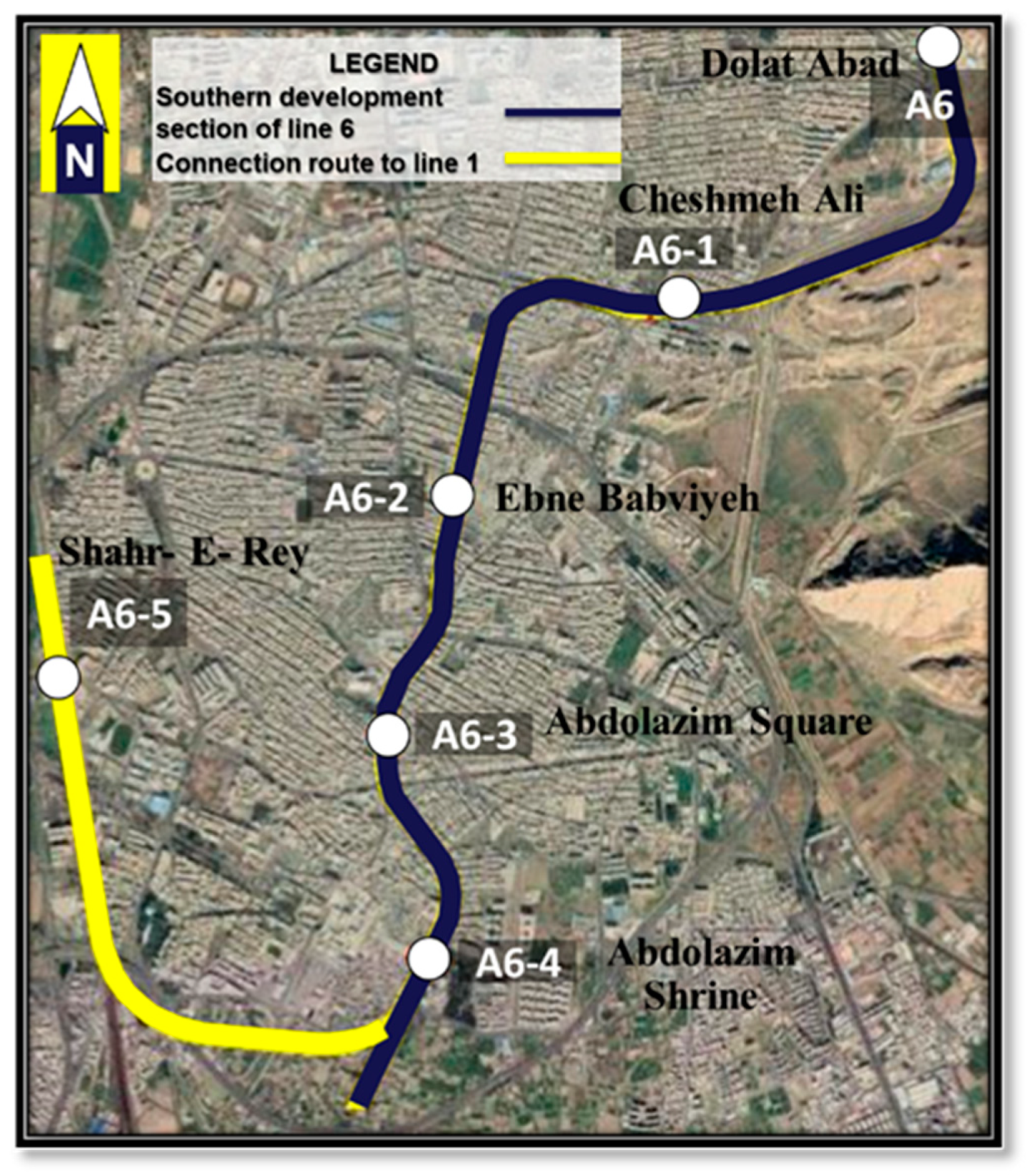

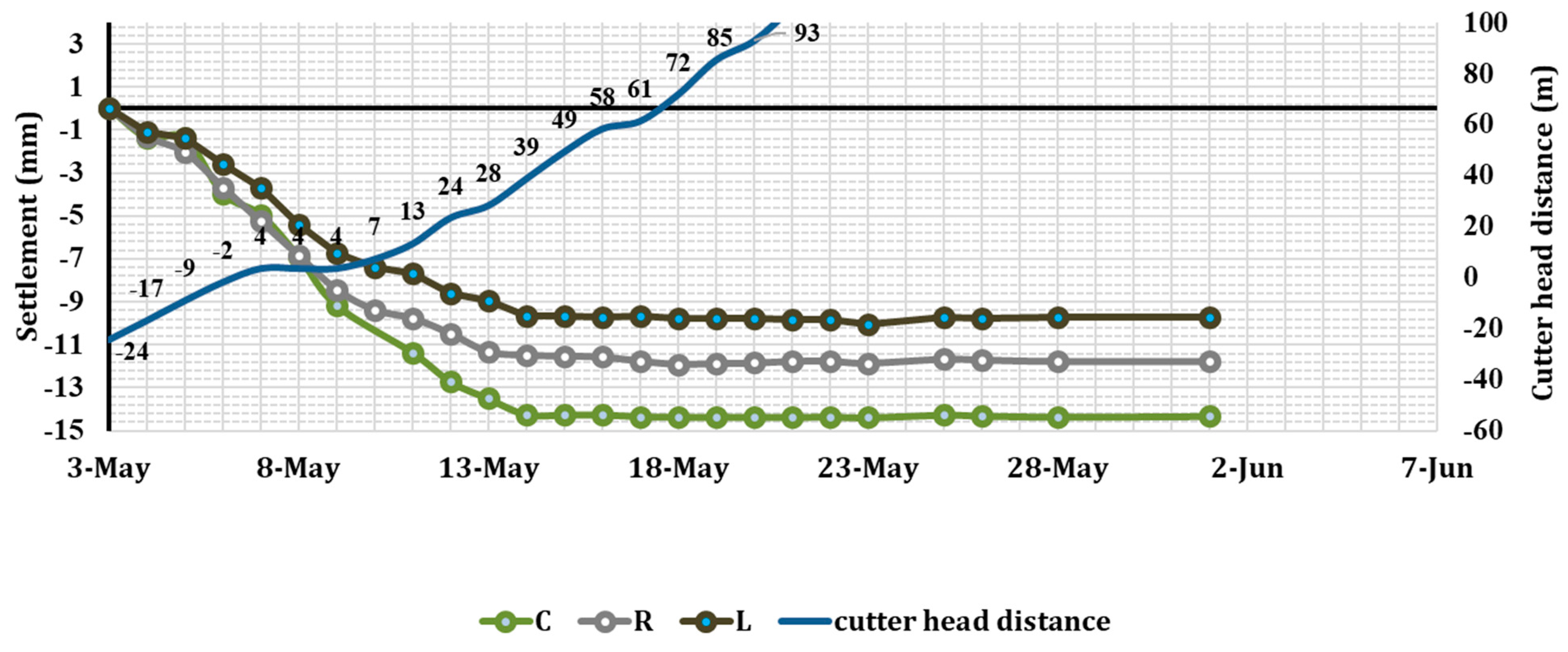
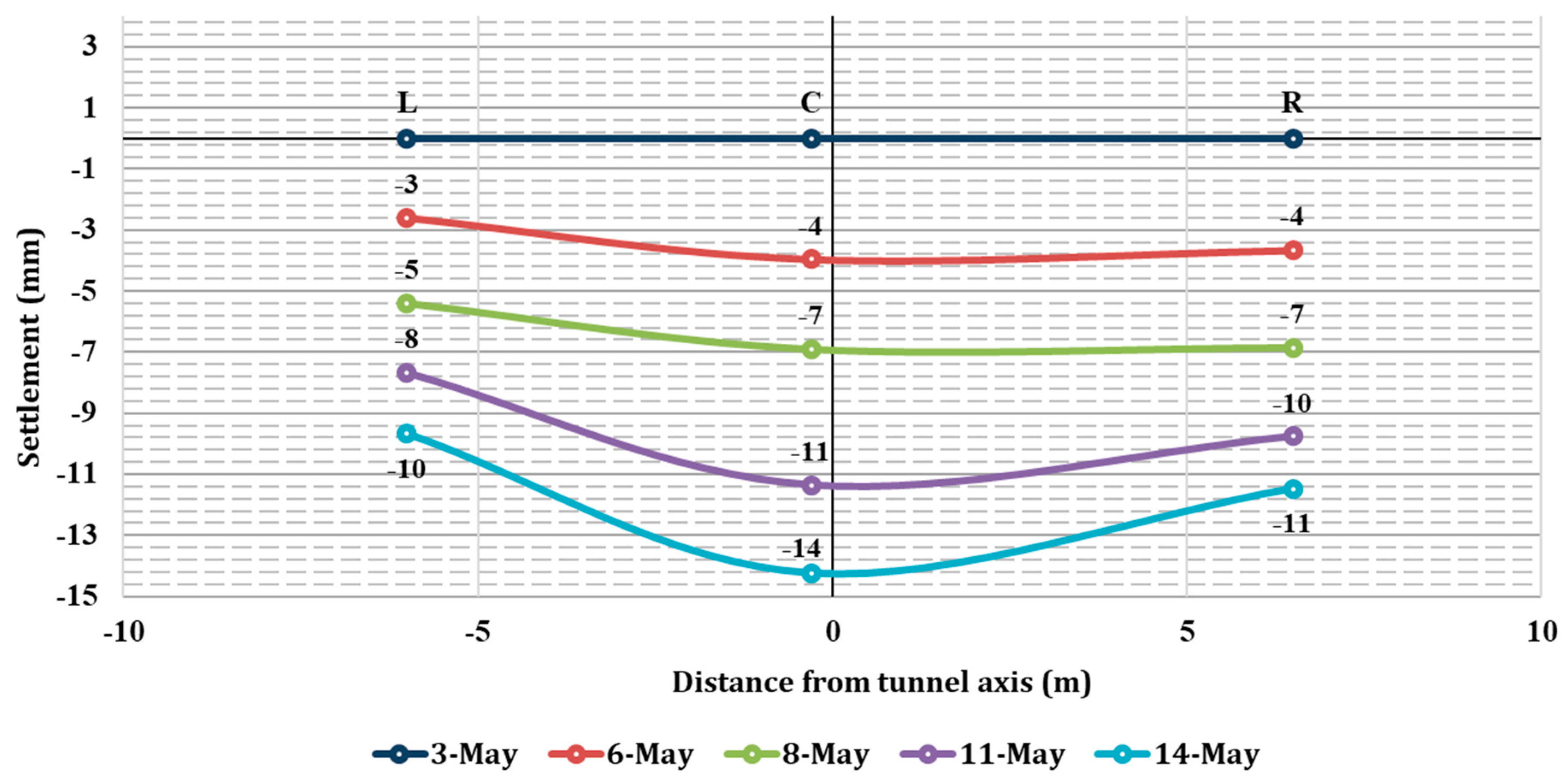

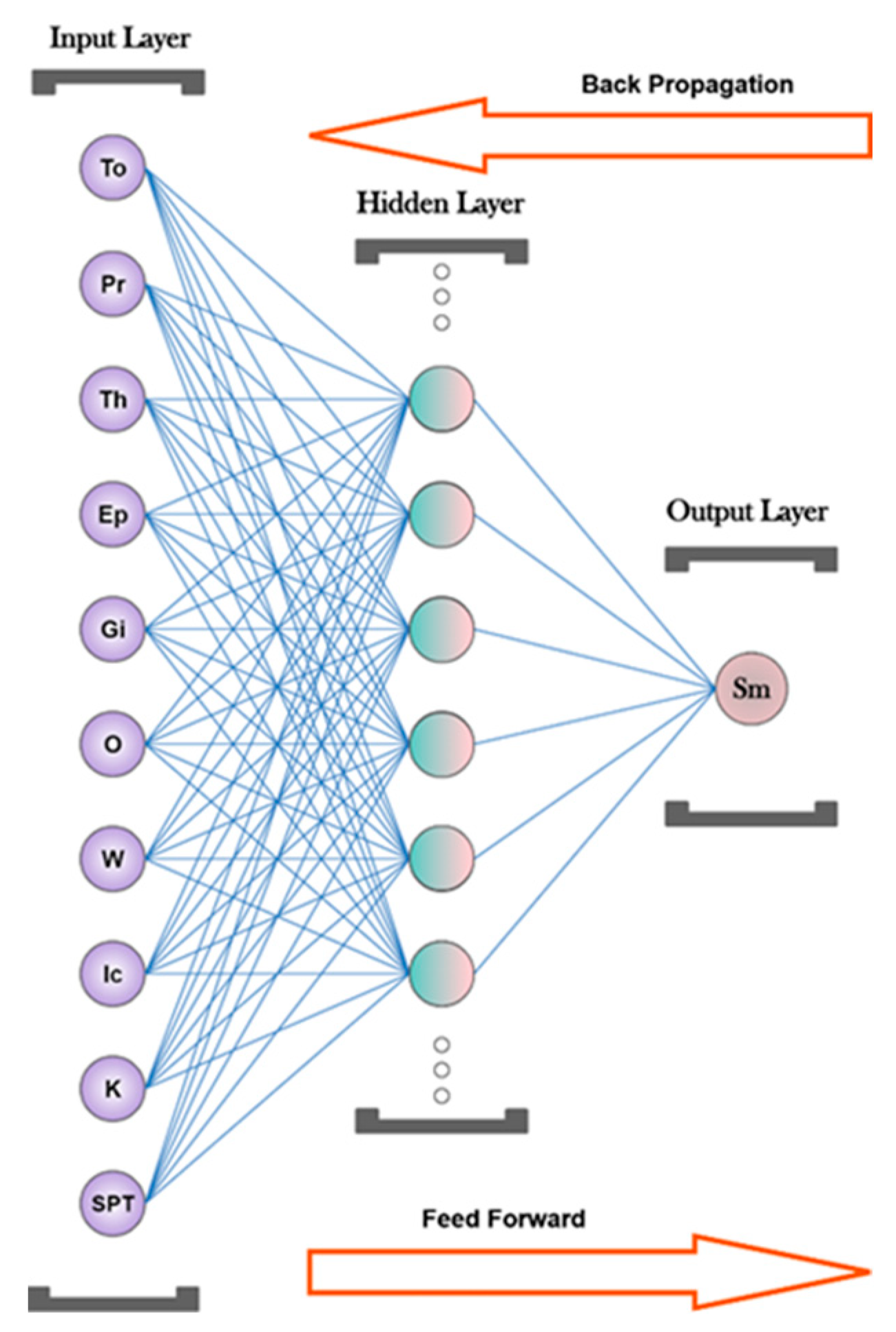
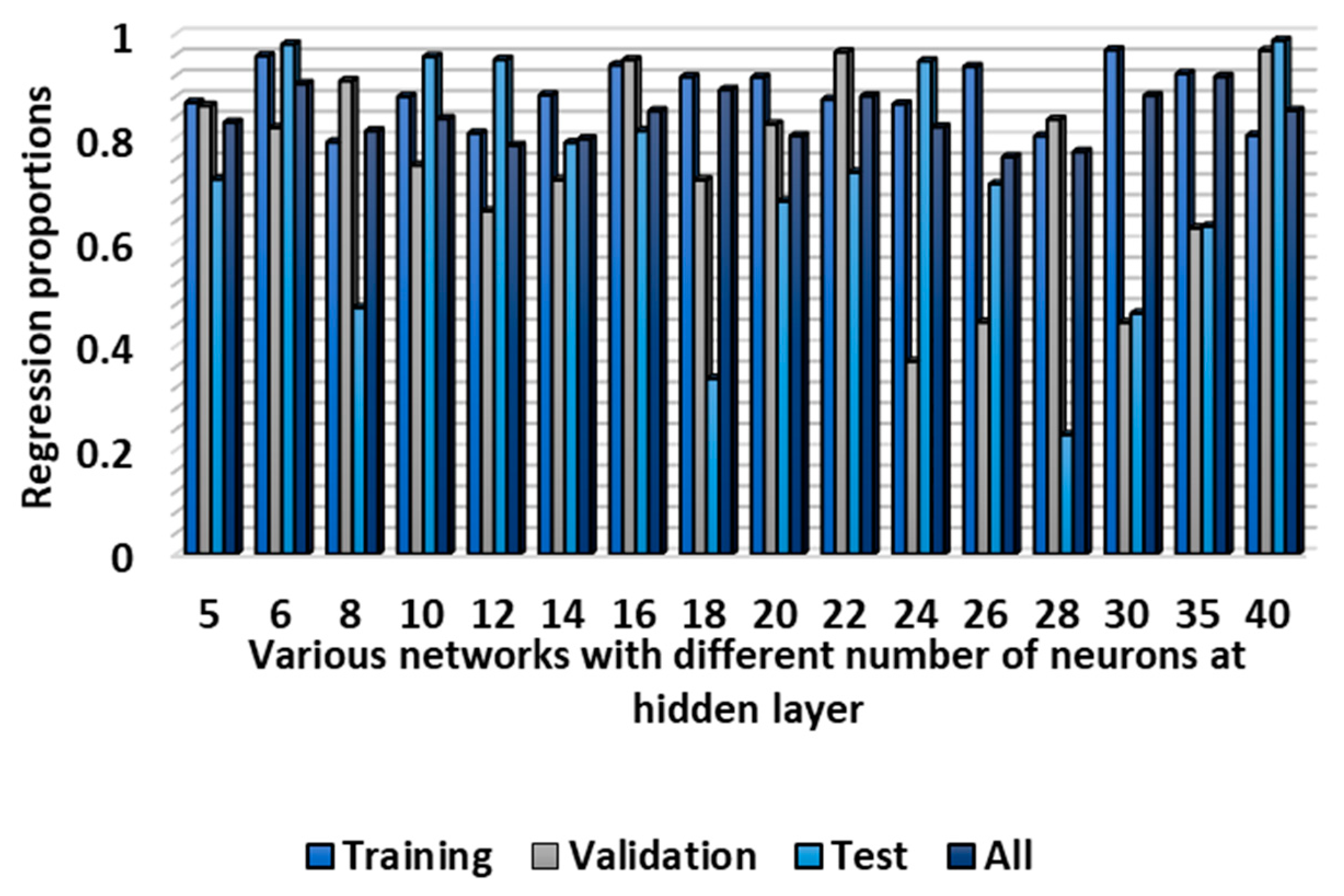
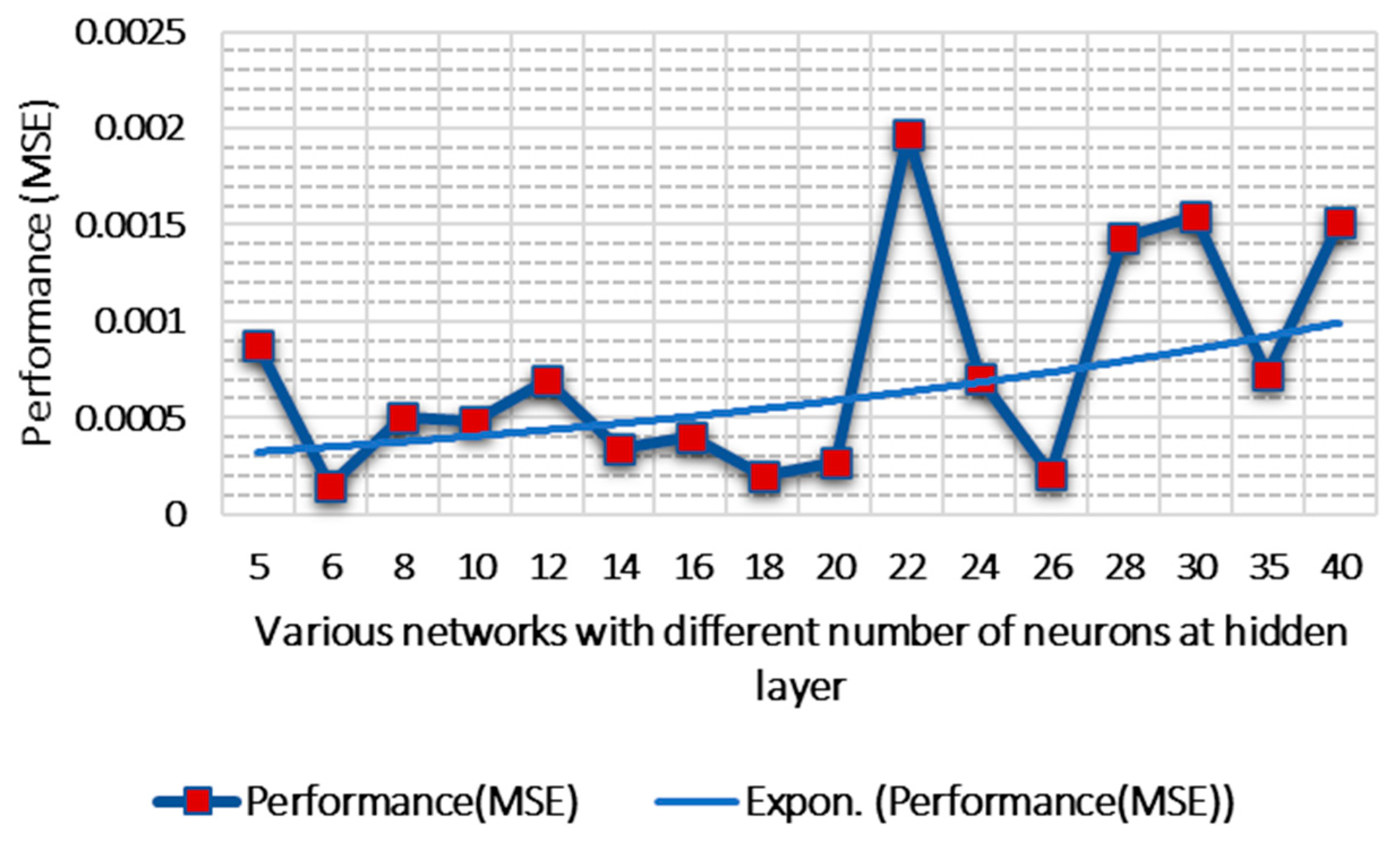
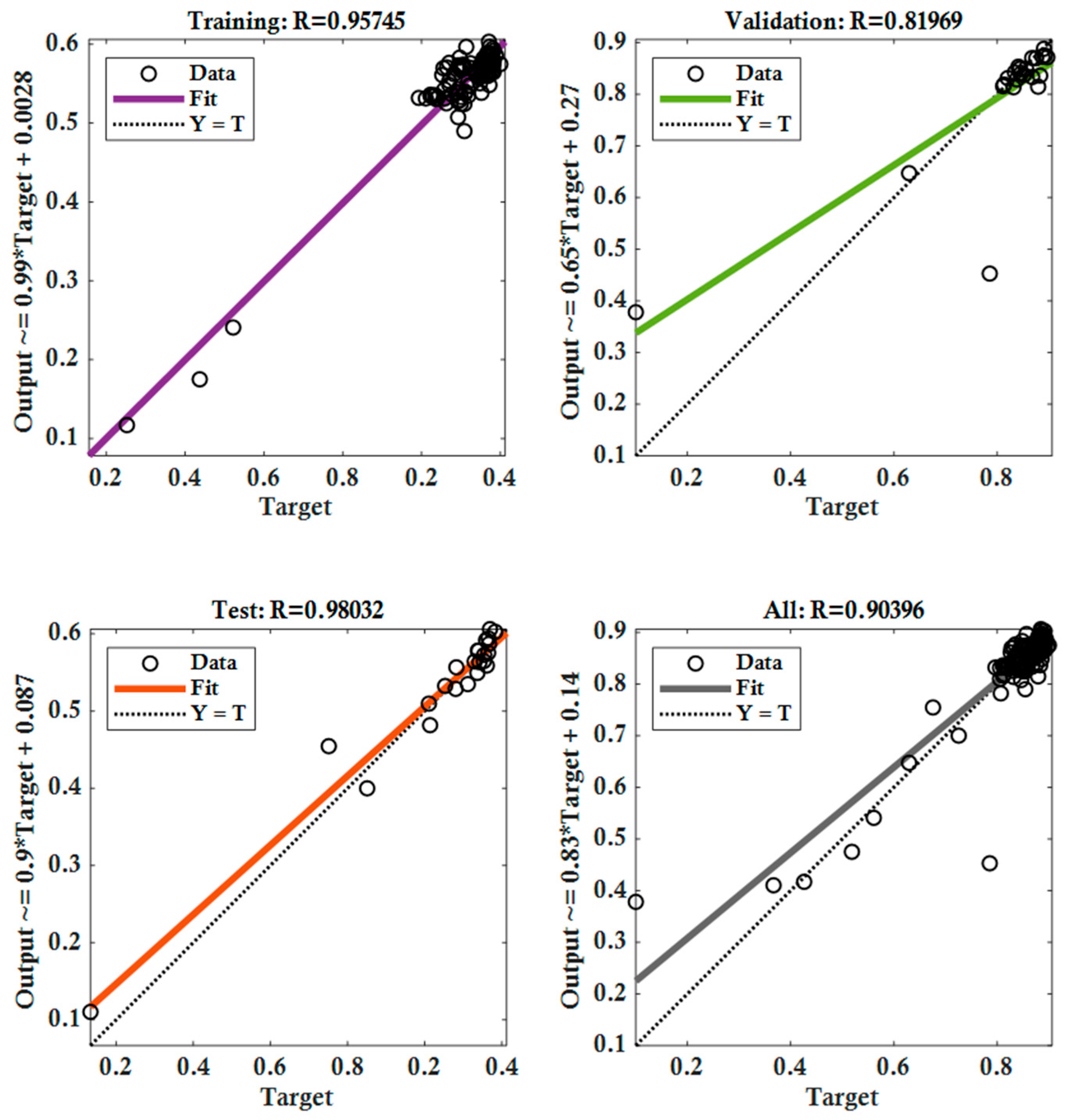
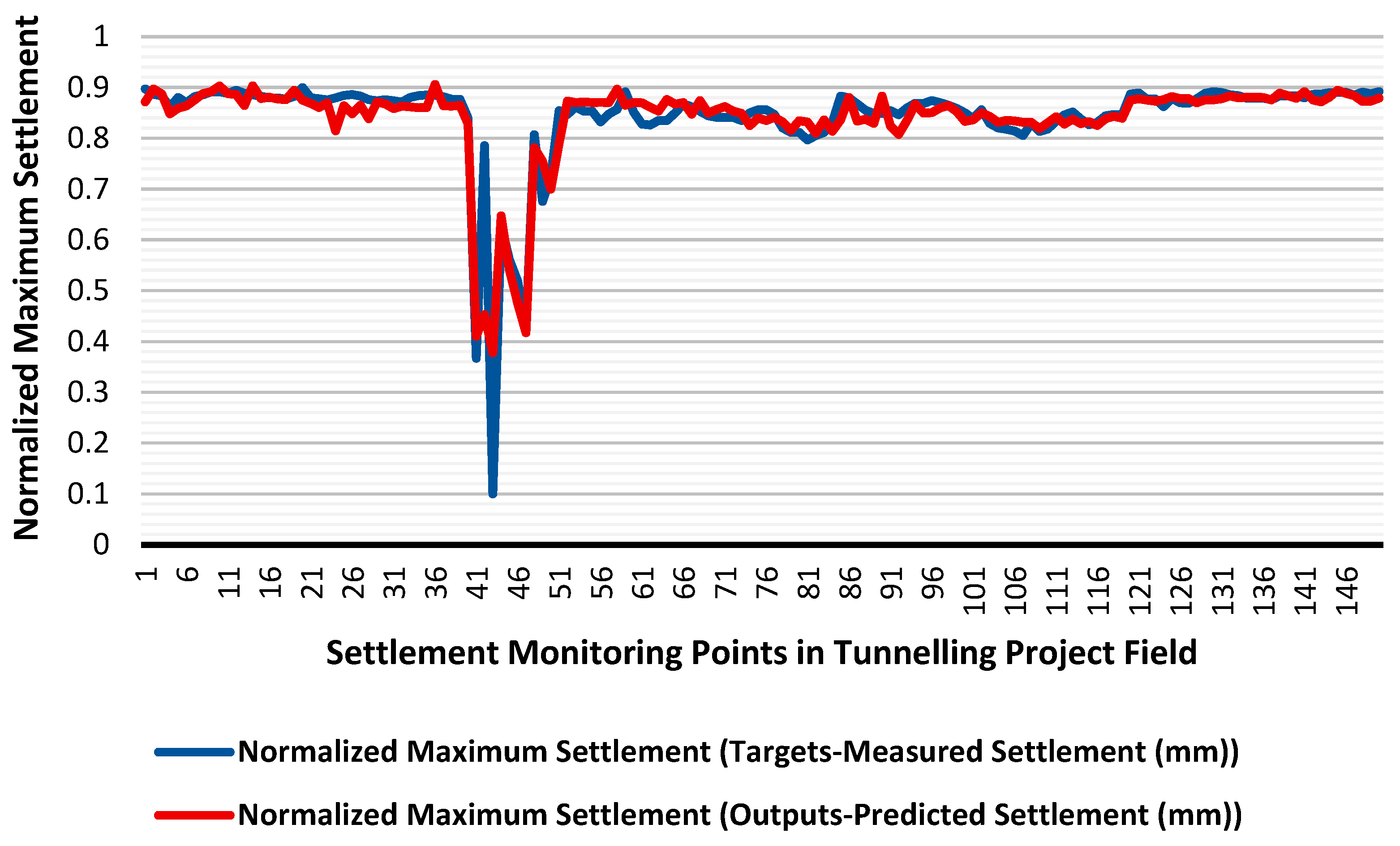

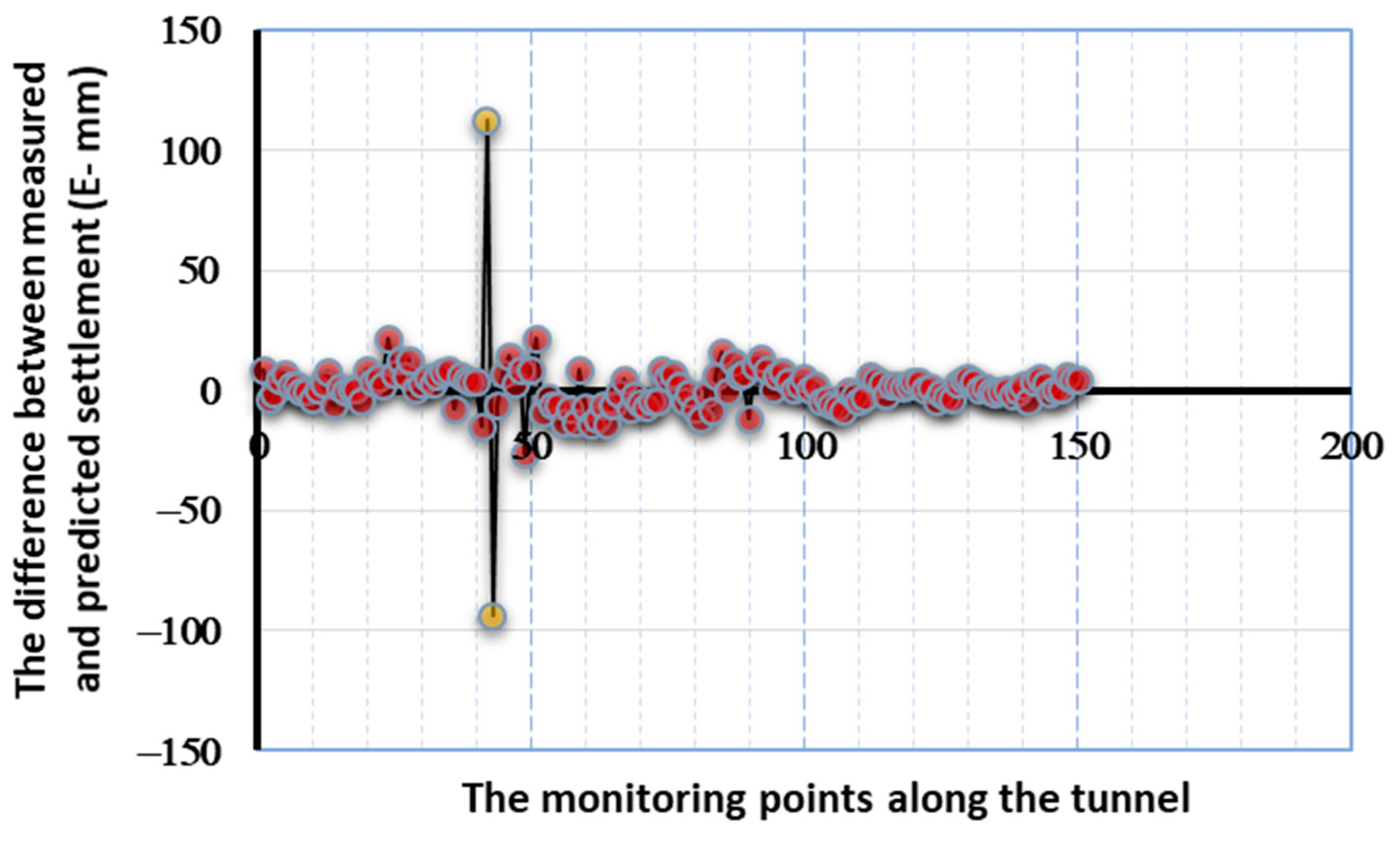
| Reference | Technique | Input Variables | Output | Sample Size |
|---|---|---|---|---|
| Kim C. Y. et al. (2001) [25] | ANN-BP | Tunnel geometries, ground conditions, and excavation and support conditions | Maximum settlement (mm); inflection point (m) | 113 datasets |
| Shahin, M.A. et al. (2005) [28] | ANN-BP | Footing width, B; footing net applied pressure, q; soil compressibility, N = f(SPT); footing geometry, L/B; footing embedment ratio, Df/B | Foundation settlement, Sm | 189 datasets |
| Suwansawat S. et al. (2006) [24] | ANN-BP | Depth (m), distance from shaft (m), geology at crown; geology at invert; face pressure, average penetrate; pitching, grouting pressure (bar), and grout filling (%) | Maximum settlement (mm) | 49 datasets |
| Pourtaghi, A. et al. (2012) [17] | Wavenet, BP | Depth (m), distance from shaft (m), geology at the crown and at invert; invert to WT (m), average face pressure, average penetrate; pitching, grout pressure (bar), and grout filling (%) | Maximum settlement (mm) | 49 datasets |
| Ahangari, K. et al. (2015) [29] | ANFIS, GEP | Elasticity modulus, cohesion, angle of internal friction, tunnel diameter, and tunnel depth | Settlement (mm) | 53 datasets |
| Bouayad D, Emeriault F. (2017) [23] | PCA, ANFIS | The dataset consisted of 15 variables (10 parameters + 5 thicknesses) | Settlement (mm) | 95 datasets |
| Chen, R. et al. (2019) [43] | BPNN, WNN, GRNN, ELM, SVM, RF | Cover depth, torque, penetration rate, thrust, face pressure, grout filling, tunnel depth below the water table, modified standard penetration test, modified dynamic penetration test, and modified uniaxial compressive strength | Maximum settlement (mm) | 200 datasets |
| Chen, R. et al. (2019) [31] | BP-RBF-GRNN | Cover depth, torque, penetration rate, thrust, face pressure, grout filling, tunnel depth below the water table, modified standard penetration test, modified dynamic penetration test, and modified uniaxial compressive strength | Maximum settlement (mm) | 200 datasets |
| W.G. Zhang. et al. (2021) [3] | ANN-SVM-MARS-XGBoost | Cover (H), advance rate, earth pressure, grout pressure, mean moisture content, mean soil elastic modulus, mean SPT above a crown level, and mean tunnel SPT | Surface settlement (mm) | 148 datasets |
| Variable (Abbreviation) | Parameter Type | Data (150) | Unit | ||||
|---|---|---|---|---|---|---|---|
| Minimum | Maximum | Mean | Standard Deviation | Coefficient of Variation | |||
| Torque (To) | Input | 1.4 | 145.3 | 5.24 | 12.33 | 2.35 | MN.m |
| Penetration rate (Pr) | Input | 5 | 28 | 17.78 | 5.43 | 0.31 | mm/rev |
| Thrust (Th) | Input | 6421 | 34,004 | 20,571.19 | 4400.60 | 0.21 | KN |
| Earth pressure (Ep) | Input | 0 | 1.57 | 0.58 | 0.52 | 0.91 | bar |
| Grout injection (Gi) | Input | 0 | 20,401 | 7608.83 | 2418.99 | 0.32 | L |
| Overburden (O) | Input | 12 | 28 | 22.66 | 4.2 | 0.19 | m |
| Average Ground Water Head (W) | Input | 0 | 20 | 6.33 | 7.47 | 1.18 | m |
| Consistency index (Ic) | Input | 0.75 | 1 | 0.93 | 0.11 | 0.12 | / |
| Permeability (K) (normalized) | Input | 4 | 5 | 4.09 | 0.29 | 0.07 | cm/s |
| Standard penetration test (SPT) | Input | 42.5 | 50 | 49.85 | 1.05 | 0.02 | / |
| Maximum settlement (Sm) | Output | 1.1 | 271 | 20.44 | 32.22 | 1.58 | mm |
| Inputs | Target | |||||||||
|---|---|---|---|---|---|---|---|---|---|---|
| EPB Operation Factors | Tunnel Geometry | Geological Conditions | Geotechnical Parameters | Geomechanical Property | ||||||
| Torque (MNM) | Penetration Rate (MM/REV) | Thrust (KN) | Earth Pressure (bar) | Grout Injection (Liter) | Overburden (m) | Average Ground Water Head (m) [above tunnel invert] | Consistency Index | Permeability[K] (cm/s) | SPT | Maximum Settlement (mm) |
| To variable weights | Pr variable weights | Th variable weights | Ep variable weights | Gi variable weights | O variable weights | W variable weights | Ic variable weights | K variable weights | SPT variable weights | Sm variable weights |
| −0.49498 | −0.54981 | −0.15513 | −0.68738 | −0.40614 | 0.30172 | −0.42069 | 1.066 | −0.56721 | 0.27626 | 0.36375 |
| −0.57798 | 1.837 | −2.2687 | 0.40548 | −1.7553 | −1.0539 | −1.4286 | −0.0074235 | −0.21261 | 0.86451 | 0.64147 |
| −0.39237 | 0.69576 | −0.219 | −0.81171 | −1.6462 | −0.34858 | 0.67705 | 0.072822 | 0.24652 | 0.21439 | −0.2348 |
| −0.34867 | 0.13305 | 0.33614 | 0.83335 | 1.7668 | 0.70232 | −0.40434 | 1.2111 | 0.083767 | 0.19734 | −0.37165 |
| 1.2353 | −0.36861 | −0.02889 | −0.41278 | 0.45023 | 0.46062 | 0.70425 | 0.37891 | 0.04882 | 0.5098 | 0.10354 |
| −0.42897 | −0.56726 | −0.71115 | −1.2769 | 0.40772 | −0.57415 | 0.14446 | −1.2076 | −0.63396 | 0.539 | −0.27575 |
Disclaimer/Publisher’s Note: The statements, opinions and data contained in all publications are solely those of the individual author(s) and contributor(s) and not of MDPI and/or the editor(s). MDPI and/or the editor(s) disclaim responsibility for any injury to people or property resulting from any ideas, methods, instructions or products referred to in the content. |
© 2023 by the authors. Licensee MDPI, Basel, Switzerland. This article is an open access article distributed under the terms and conditions of the Creative Commons Attribution (CC BY) license (https://creativecommons.org/licenses/by/4.0/).
Share and Cite
Moghtader, T.; Sharafati, A.; Naderpour, H.; Gharouni Nik, M. Estimating Maximum Surface Settlement Caused by EPB Shield Tunneling Utilizing an Intelligent Approach. Buildings 2023, 13, 1051. https://doi.org/10.3390/buildings13041051
Moghtader T, Sharafati A, Naderpour H, Gharouni Nik M. Estimating Maximum Surface Settlement Caused by EPB Shield Tunneling Utilizing an Intelligent Approach. Buildings. 2023; 13(4):1051. https://doi.org/10.3390/buildings13041051
Chicago/Turabian StyleMoghtader, Tohid, Ahmad Sharafati, Hosein Naderpour, and Morteza Gharouni Nik. 2023. "Estimating Maximum Surface Settlement Caused by EPB Shield Tunneling Utilizing an Intelligent Approach" Buildings 13, no. 4: 1051. https://doi.org/10.3390/buildings13041051






